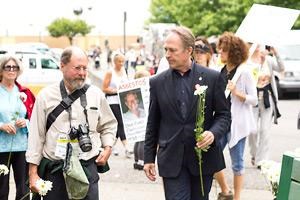A crowd gathered outside Powell River Recreation Complex June 22 to listen to stories of the continued danger of asbestos use and walked to raise community awareness about the “silent killer’s” deadly legacy.
The second annual Walk for Truth-Asbestos Kills rally was organized by the AREA (Asbestos-related Research, Education and Advocacy) Fund, an organization that was created by the Ford family after Dave Ford, a Powell River resident, died of mesothelioma, a terminal form of cancer in the lining of the lungs caused by asbestos.
Event organizers marked the World Health Organization’s estimate that 107,000 people die each year due to asbestos-related illness by having participants throw 107 white daisies into McGuffie Creek when the charity walk began.
Mayor Dave Formosa spoke to the group of approximately 110 participants and 30 guests from around the province about the need to take the next step in the battle against asbestos.
“Some say there’s no cure, but there is one,” said Formosa. “And it’s building awareness.”
Formosa, who lost an uncle to mesothelioma, said that he would work with the local unions to pull together more grassroots support.
Asbestos-related diseases are the number one occupational killer in BC and across Canada. It’s estimated that over 1,500 people in BC will die from asbestos-related diseases over the next five years. Approximately 26,000 workers in BC are still at risk of exposure in the workplace.
Scott McCloy, director of community relations for WorkSafeBC, was not able to attend the rally, but did send a statement to be read. In it he explained that last year nearly 60 per cent of the fatalities accepted by WorkSafeBC were for occupational disease and the vast majority of these were from asbestos exposures 30 or 40 years ago.
“WorkSafeBC is concerned that many people in BC believe that the threat of asbestos is over, but workers continue to be exposed particularly in the demolition of old buildings,” McCloy’s statement read. “WorkSafeBC has a special team of inspectors monitoring those demolitions trying to prevent workplace exposure.”
The provincial work safety organization has launched a website so that any worker who thinks they have been exposed can register.
The majority of people becoming sick with mesothelioma are tradespeople who were exposed to asbestos before regulations around the dangerous material were tightened 15 years ago. However, Tracy Ford, the event’s organizer, said she is concerned about a second wave of people getting sick: homeowners who are performing their own home renovations.
Homes built before the early 1990s were sometimes constructed with materials that contained the invisible fibres. Common building materials like plaster, drywall joint compound, sheet flooring vinyl and some wiring insulation can contain asbestos.
Chris Martin owns AREC, a consulting company in Victoria which helps homeowners and contractors find and evaluate asbestos threats in homes and businesses. “It amazes me the materials that contain asbestos,” he said. “It’s unfortunate but most people don’t have a clue.”
Dr. Tim Takaro, physician, scientist and professor of health sciences at Simon Fraser University, spoke about the future of asbestos-related deaths noting that while Canadian doctors are expecting a decrease in numbers over the coming decades, that same trend will not be seen in developing countries in Asia where up until last year Canada continued to export asbestos.
“The deaths that we will commemorate with these 107 daisies will largely be from our neighbours in developing countries in the future,” said Takaro. “These deaths are also preventable.”
Canada’s last asbestos mine, located in Quebec, closed down in September 2012 and international exports have dwindled to a trickle, he said.
Winnipeg New Democratic Party MP Pat Martin, no relation to the owner of AREC, actively campaigns to have Canada ban the production and exporting of asbestos. He returned to the rally for a second year.
“The last asbestos mine has closed, but it closed through normal market forces, not through any political courage by our government,” said Pat. “It died a natural death. I’m not sure it’s anything to celebrate.
“Our government’s policy on asbestos is morally and ethically reprehensible,” he added. “Ask people on the street and most will tell you it’s banned. There’s no law against importing asbestos, manufacturing asbestos products and exporting them around the world.”
Other speakers were Tracy, Doug Jones, recently retired president of SteelWorkers Union Local 480, and Stacy Mogan who gave a moving account of her own father’s life and death.
More information about the AREA Fund is available online. WorkSafeBC’s asbestos exposure registry can be found on its website.



